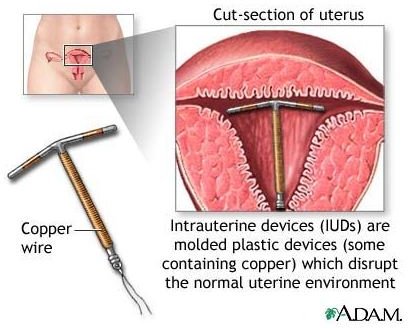Intrauterine Device: IUD Information
IUD Information
The IUD (intrauterine device) is a small T-shaped device made of flexible plastic that is placed inside the uterus to prevent pregnancy. A string is attached to the end of the IUD that hangs down into the upper portion of the vagina (it is not noticeable during intercourse). In the United States, there are two brands available: ParaGard and Mirena. The ParaGard is a copper IUD and the Mirena is a hormonal IUD.
Both devices are said to prevent pregnancy by affecting the movement of sperm (keeping the sperm away from the egg) and by altering the lining of the uterus (preventing the implantation of a fertilized egg). Progestin, the hormone in the Mirena IUD, keeps the ovaries from releasing eggs and thickens cervical mucus (blocking sperm from the egg). Click on image to enlarge.
Advantages
Effectiveness. The IUD is one of the most effective contraceptives available (less than 1% with the copper IUD and less than 2% with the hormonal IUD). You are protected until the IUD is removed.
Convenience. Permits spontaneity of intercourse and requires no daily attention (like taking birth control pills every day).
Long lasting. Can last 5-12 years. Can be removed by a health care provider at any time.
Inexpensive. Considering how long the device works, the cost is normally a lot less expensive than other birth controls. The cost can vary (normally between $175 - $650). Private insurance and Medicaid may cover the cost.
Breastfeeding. Women can breastfeed with an IUD.
Satisfaction. The majority of women who have IUDs are satisfied.
Disadvantages
Inconvenience. Clinic visits are required for insertion and removal.
Pain. You may experience some pain during insertion and removal. You may have some cramps and backache for a few hours or few days after insertion. You may have pain for a couple of weeks after insertion. You may have worse menstrual cramps with ParaGard.
Difficult periods. You may have spotting between periods during the first 3-6 months. You may have irregular periods in the first 3-6 months with Mirena. You may have excessive menstrual flow with ParaGard.
Expulsion of the device. The IUD may slip out of place or come all the way out.
Infection. It is possible to develop an infection from insertion. If so, most occur within 3 weeks of insertion. This is rare. There is also a possibility of the IUD pushing through the wall of the uterus. This is very rare.
Complications
The following are complications that require prompt medical assistance:
- inability to locate the string (you will need to check for the IUD string at least once a month)
- suspected or obvious expulsion of IUD
- severe cramping, tenderness, or pain in the abdomen
- pain or bleeding during intercourse
- unusually heavy bleeding
- unusually prolonged bleeding
- bleeding between periods
- unusual vaginal discharge
- signs of an infection (fever/chills)
- signs of pregnancy.
Who Should Not Have an IUD
Not all women should use an IUD. Your doctor will help you decide if it is right for you. Women who have unexplained vaginal bleeding, abnormal pap smears, or low immune response are some who may be advised against using an IUD.
More IUD Information
Although insertion can be done at any time, it is preferred to do it during menstruation when the cervix is slightly open. This also helps ensure that the woman is not pregnant.
Depending on the day of the month the insertion is performed, you may have to wait a few days before protection takes place.
IUDs do not protect against sexually transmitted diseases.
If a woman becomes pregnant with an IUD in place, she has an increased risk of having an ectopic pregnancy (implantation takes place outside of the uterus, mostly the fallopian tubes).
IUDs have improved since the older versions (which are no longer available). Serious side effects (such as pelvic inflammatory disease and infertility) from the older versions are rare with the new IUDs.
References
Intrauterine Device (IUD): https://familydoctor.org/online/famdocen/home/women/contraceptive/319.html
IUD: https://www.plannedparenthood.org/health-topics/birth-control/iud-4245.htm
Photo Credit
Image courtesy of the National Library of Medicine (NLM).
